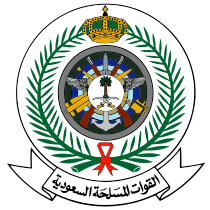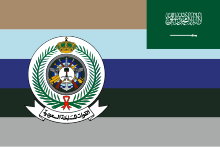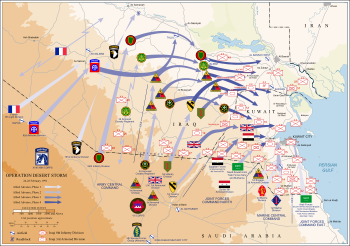Armed Forces of Saudi Arabia
| Saudi Arabian Armed Forces | |
|---|---|
| القُوَّات السُّعُودِيَّة المُسَلَّحَة | |
 Emblem of the Armed Forces | |
 Flag of the Armed Forces | |
| Founded | 1744[1] |
| Current form | 1902 |
| Service branches |
|
| Headquarters | Air Chief Marshal Fayyadh Al Ruwaili |
| Personnel | |
| Military age | 17[2] |
| Conscription | No[3] |
| Active personnel | 257,000[4] |
| Deployed personnel | |
| Expenditures | |
| Budget | US$75 billion (2023) |
| Foreign suppliers | |
| Related articles | |
| History |
|
| Ranks | KSA military ranks |
The Saudi Arabian Armed Forces (SAAF) (
The Royal Saudi Armed Forces are one of the best-funded in the world,
History
The first steps towards building an institutionalised armed force for Saudi Arabia began in the 1940s, when Saudi regulars numbered perhaps 1,000–1,500, Gaub saying that officers mostly came from the Ottoman troops who had served the
In 1987, members of the air force, army, and navy used to be mainly recruits from groups of people without a strong identity from the
King Abdullah increasingly moved towards comprehensive military reform following what he considered a failed response by Saudi forces to Houthi incursions in 2009.[22]
In the early 2010s, after almost 20 years of relatively modest increases in military spending, the Saudi government embarked an unprecedented expansion of the Kingdom's armed forces.[23][24] This shift in policy was spear-headed primarily by Crown Prince Mohammed bin Salman, who took over as Defense Minister in 2015.[25] It is believed the continued high level expansion of the Saudi Armed Forces was a response to not only short term threats (including incursions by Yemeni rebels and the rise of ISIS) but long term regional strategic concerns, namely the increasing strength of Iran and the uncertain future of America's role in the region.[26]
In 2019, the government of Saudi Arabia stated that women can start working in the military. In the past they could only work in police.[27]
Military services
The armed forces are mainly the responsibility of the
Defense spending

Spending on defense and security has increased significantly since the mid-1990s and was about US$67 billion in 2013. Saudi Arabia ranks among the top five nations in the world in government spending for its military, representing about 9% of GDP in 2013. Its modern, high-technology arsenal makes Saudi Arabia among the world's most densely armed nations, with its military equipment being supplied primarily by the United States, France, and Britain.
The United States sold more than $80 billion in military hardware between 1951 and 2006 to the Saudi military.
The United Kingdom has also been a major supplier of military equipment to Saudi Arabia since 1965.[35]
Canada recently won a contract worth at least US$10 billion to supply the Saudi Arabian army with armored military vehicles.[36]
Service branches
Army
The
The army's main equipment consists of a combination of French- and U.S.-made armored vehicles: 315 M–1A2 Abrams, 290
In 1996 Saudi Arabia had military cities in the northeast, the King Khalid Military City, at Tabuk, at Dharhran, and at Abha in the southwest. There was a 1996 report that construction of a military city at Jizan, orientated toward Yemen, had begun with Defense Minister Prince Sultan pouring the first concrete on 8 May 1996.[37]
The

The navy is divided into two fleets: the Western Fleet has bases in
The navy's inventory includes 11 principal
Air Force

The air force is organized in seven fighter/ground-attack squadrons, six fighter squadrons, and seven training squadrons. Saudi Arabia has at least 15 active military airfields.[28]
As of 2011, Saudi Arabia has around 300 combat aircraft. The kingdom's combat aircraft are newly acquired Typhoons and upgraded Tornado IDS, F-15 Eagle and F-15E Strike Eagle fighter planes. Saudi Arabia has a further 80+ F-15 Eagles on order and an option to buy another 72 Typhoons.
Air Defense

Air Defense was part of the Army until 1981 when it was made a separate service. It operates "Peace Shield" a state-of-the-art radar and air defense system consisting of a Command Operations Center at
The system equipment comprises 17 General Electric
Strategic Missile Force
The Royal Saudi Strategic Missile Forces (RSSMF) is equipped with the Chinese DF-3A (CSS-2) Dongfeng missile sold to Saudi Arabia by China. A conventional high-explosive warhead (2150 kg) variant of the DongFeng 3A Intermediate-Range Ballistic Missile was developed for an export order to Saudi Arabia in 1987. About 30+ missiles and 9~12 launchers were reportedly delivered in 1988, though no known test launch has ever been made in the country.[40][41] IISS Military Balance 2022 estimates that the SMF has 2,500 personnel. Probably it is separate branch officially called Strategic Missile Forces (guessing by its website URL http://www.smf.gov.sa/ Archived 15 January 2013 at the Wayback Machine).
It certainly has one advanced
Armed Forces Medical Service
Armed Forces Medical Service of Saudi Arabia provides medical services to all members of the Armed Forces. It is led by a Director General and is responsible for 24 military hospitals across Saudi Arabia.[43]
The service operates aero lift operations with its own fleet of aircraft:
- Lockheed Martin VC-130H flying hospital
- Bell 212 helicopter
- Aerospatile Dolphin 365N helicopter
- Sikorsky UH60 Desert Hawk helicopter
- Learjet
- Gulfstream G3
- Gulfstream G4
- Gulfstream G5
Major military operations
Grand Mosque seizure
In 1979, Islamic extremists took control of the Grand Mosque in Mecca. The extremists were led by Juhayman Al Otaiba and held many worshippers hostage for weeks.
With the help of Pakistani and Western troops, the Saudi military captured the terrorists inside the Grand Mosque.[44]
Gulf War

When
Operation Southern Watch
Since the Gulf War, the United States stationed 5,000 troops in Saudi Arabia, a figure that rose to 10,000 during the 2003 conflict in Iraq.[46] Operation Southern Watch enforced the
This was one of the stated motivations behind the September 11 attacks,[46] as well as the Khobar Towers bombing.[47] Bin Laden interpreted the Islamic prophet, Muhammad as banning the "permanent presence of infidels in Arabia".[48]
Shia insurgency in Yemen
On 5 November 2009, the
Ranks
Military industry
The vast majority of Saudi Arabia's military equipment is imported from the Western world.[28] The United States sold more than $80 billion in military hardware between 1951 and 2006 to the Saudi military.[50] 2013 saw Saudi military spending climb to $67bn, overtaking that of the UK, France and Japan to place fourth globally.[51] The United Kingdom has also been a major supplier of military equipment to Saudi Arabia since 1965.[52] Since 1985, the UK has supplied military aircraft—notably the Tornado and Eurofighter Typhoon combat aircraft—and other equipment as part of the long-term Al-Yamamah arms deal estimated to have been worth £43 billion by 2006 and thought to be worth a further £40 billion.[53] In 2012, British defence giant BAE signed a £1.9bn ($3bn) deal to supply Hawk trainer jets to Saudi Arabia.[54]
According to the Stockholm International Peace Research Institute, in 2010–14 Saudi Arabia became the world's second-largest arms importer, receiving four times more major arms than in 2005–2009. Major imports in 2010–14 included 45 combat aircraft from the UK, 38 combat helicopters from the U.S., four tanker aircraft from Spain, and over 600 armoured vehicles from Canada. Saudi Arabia received 41% of UK arms exports in 2010–14.[55] France authorized $18 billion in weapons sales to Saudi Arabia in 2015 alone.[56] The $15 billion arms deal with Saudi Arabia is believed to be the largest arms sale in Canadian history.[57] In 2016, the European Parliament decided to temporarily impose an arms embargo against Saudi Arabia, as a result of the Yemen civilian population's suffering from the conflict with Saudi Arabia.[58] In 2017, Saudi Arabia signed a 110 billion dollar arms deal with the United States. Saudi Arabia is Britain's largest arms customer, with more than £4.6 billion worth of arms bought since the start of Saudi-led coalition in Yemen. According to a report from the Global Affairs Canada, a record-breaking amount of military hardware was sold to Saudi Arabia in 2019, despite its poor human rights record.[59]
Following the assassination of Jamal Khashoggi, a nonbinding resolution was passed in the European Parliament on 25 October 2018, urging EU countries to impose an EU-wide arms embargo on Saudi Arabia.[60] Germany became the first Western government to suspend future arms deal with the kingdom after Angela Merkel stated that "arms exports can't take place in the current circumstances."[61]
The
See also
- Saudi Arabian Military Forces
- Saudi Arabian National Guard
- Saudi Royal Guard Regiment
- Nuclear program of Saudi Arabia
- King Khalid Military City
References
Citations
- ^ Sir James Norman Dalrymple Anderson. The Kingdom of Saudi Arabia. Stacey International, 1983. p. 77.
- ^ "The World Factbook". Langley, Virginia: Central Intelligence Agency. Archived from the original on 22 March 2016. Retrieved 6 April 2016.
- ^ "Middle East: Saudi Arabia". The World Factbook. Langley, Virginia: Central Intelligence Agency. 17 October 2018. Archived from the original on 27 August 2021. Retrieved 21 October 2018.
- ISBN 978-1-032-27900-8.
- ^ Felicia Schwartz; Hakim Almasmari; Asa Fitch (26 March 2015). "Saudi Arabia Launches Military Operations in Yemen". The Wall Street Journal. Archived from the original on 24 February 2020. Retrieved 4 August 2017.
- ^ Henderson, Simon. "Bahrain's Crisis: Saudi Forces Intervene". Washington Institute. Archived from the original on 4 April 2016. Retrieved 19 March 2016.
- ^ "Saudi Arabia launches airstrikes in Yemen". CNN. 26 March 2015. Archived from the original on 26 March 2015. Retrieved 26 March 2015.
- ^ "Djibouti welcomes Saudi Arabia plan to build a military base". middleeastmonitor.com. 28 November 2017. Retrieved 28 November 2017.
- ^ Shrivastava, Sanskar (15 March 2011). "Saudi Arabian Troops Enter Bahrain, Bahrain Opposition Calls It War". The World Reporter. Archived from the original on 18 March 2011. Retrieved 15 April 2011.
- ^ "Trends in World Military Expenditure, 2022" (PDF). Stockholm International Peace Research Institute. April 2023. Archived (PDF) from the original on 23 April 2023. Retrieved 29 April 2023.
- ^ http://uk.businessinsider.com/saudi-arabia-spends-25-of-its-budget-on-its-military-2015-12" Archived 2 January 2016 at the Wayback Machine, 31 December 2015,
- ISBN 978-1032012278.
- ISBN 9781849046480.
- ^ Smith, Charles D. (2006), Palestine and the Arab–Israeli Conflict, New York: Bedford, p. 329.
- ^ Myre, Greg. “The 1973 Arab Oil Embargo: The Old Rules No Longer Apply“ (October 16, 2013). National Public Radio. www.npr.org/sections/parallels/2013/10/15/234771573/the-1973-arab-oil-embargo-the-old-rules-no-longer-apply Retrieved January 20, 2021.
- ^ "Was the 'Oil Weapon' Effective in Achieving the Arab States' Goals in 1973–74?". 28 December 2014.
- ^ Daoudi, M. S.; Dajani, M. S. (January 1984). "The 1967 Oil Embargo Revisited". Journal of Palestine Studies. 13 (#2): 65–90. doi:10.2307/2536897. ISSN 0377-919X. JSTOR 2536897.
- ^ ""The Soviet Invasion of Afghanistan". Arab News (April 19, 2020). Retrieved 20 January 2021". Archived from the original on 5 April 2022. Retrieved 18 May 2021.
- ^ "Annex D: Iraq Economic Data (1989–2003)". Comprehensive Report of the Special Advisor to the DCI [Director of Central Intelligence] on Iraq's WMD. 1 of 3. Central Intelligence Agency. 27 April 2007
- ^ Pike, John (ed.). "Iraq debt: Non-Paris Club Creditors". Archived from the original on 12 October 2017. Retrieved 20 January 2021.
- ISBN 9780393324174.
- ^ Abeer Allam (21 April 2013). "Saudi king sacks deputy defence minister". Financial Times. Abu Dhabi. Retrieved 20 January 2021.
- ^ "Data for all countries from 1988–2018 in constant (2017) USD (pdf)" (PDF). SIPRI. Retrieved 20 January 2021.
- ^ Tian, Nan; Fleurant, Aude; Kuimova, Alexandra; Wezeman, Pieter D.; Wezeman, Siemon T. (27 April 2020). "Trends in World Military Expenditure, 2019" (PDF). Stockholm International Peace Research Institute. Retrieved 20 January 2021.
- ^ "Saudi King Abdullah passes away". Al Arabiya, (23 January 2015). Archived from the original on 23 January 2015. Retrieved January 20, 2021.
- ^ Carey, Glen (1 March 2018). "Saudi Prince's Big Military Revamp Means Billions to Business". Bloomberg. Retrieved 5 April 2022.
- ^ "Saudi women can now join the armed forces". Khaleej Times. 3 October 2019. Retrieved 16 May 2020.
- ^ a b c d e f g "Country Profile: Saudi Arabia" Archived 16 January 2011 at the Wayback Machine, September 2006, United States Library of Congress
- ^ "Trends in International Arms Transfer, 2014". Stockholm International Peace Research Institute. Archived from the original on 19 March 2015. Retrieved 18 March 2015.
- ^ "Saudi Arabia" Archived 11 November 2010 at the Wayback Machine, Federation of American Scientists
- ^ Pierre Tristam Middle East Issues Expert. "U.S. Arms Sales to Saudi Arabia". Middleeast.about.com. Archived from the original on 12 January 2011. Retrieved 21 November 2015.
- ^ "Arms for the King and His Family: The U.S. Arms Sale to Saudi Arabia". Jerusalem Center For Public Affairs. Archived from the original on 5 December 2010. Retrieved 25 December 2014.
- Anthony H. Cordesman (17 September 2010). "US-Saudi Security Cooperation, Impact of Arms Sales". Saudi-U.S. Relations Information Service. Archivedfrom the original on 13 January 2011. Retrieved 16 November 2010.
- ^ "Saudi Arms Deal Advances" Archived 16 November 2017 at the Wayback Machine, Wall Street Journal
- ISBN 978-0-7134-3815-4.
- ^ "Saudi Arabia, Canada Sign Landmark US$10B Military Vehicle Deal". HuffPost. 14 February 2014. Archived from the original on 19 January 2018. Retrieved 18 January 2018.
- ^ James Bruce, "Saudis building military city on Yemen border", Jane's Defence Weekly, 15 May 1996, p.3
- ISBN 9780844407913.
- ^ a b "Peace Shield (Saudi Arabia), Systems" Archived 28 September 2010 at the Wayback Machine, Jane's Military Communications, 5 July 2005. Retrieved 23 January 2012
- ^ "Saudi Arabia unveils part of strategic missile force – a deterrent move against Iran?". 2 May 2014. Archived from the original on 12 May 2019. Retrieved 16 May 2020.
- sinodefence, 27 February 2009.
- ^ Sean O'Connor, "Saudi ballistic missile site revealed" Archived 14 July 2013 at the Wayback Machine, IHS Jane's Defence Weekly, 10 July 2013.
- ^ "SAUDI ARABIA, KINGDOM OF". militar-medicine.com. Retrieved 16 May 2020.
- ^ "Mecca 1979: The mosque siege that changed the course of Saudi history". BBC News. 27 December 2019. Archived from the original on 17 July 2020. Retrieved 11 July 2020.
- ^ "Saudi Arabia". Encyclopædia Britannica. Archived from the original on 19 December 2013. Retrieved 25 December 2014.
- ^ a b "US pulls out of Saudi Arabia". BBC News. 29 April 2003. Archived from the original on 6 January 2010. Retrieved 29 November 2009.
- ^ Plotz, David (2001) "What Does Osama Bin Laden Want?" Archived 12 November 2007 at the Wayback Machine, Slate
- ^ Bergen, Peter L. (2001). Holy War Inc. Simon & Schuster. p. 3.
- ^ Robert F. Worth (26 October 2010). "Saudi Border With Yemen Is Still Inviting for Al Qaeda". The New York Times. Archived from the original on 24 July 2016. Retrieved 24 February 2017.
- ^ "Saudi Arabia". fas.org. Archived from the original on 11 November 2010. Retrieved 11 November 2010.
- ^ "Saudis lead Middle East military spending". 14 April 2014. Al Jazeera.
- ISBN 978-0-7134-3815-4.
- ^ O'Connell, Dominic (20 August 2006). "BAE cashes in on £40bn Arab jet deal". The Sunday Times. London.
- ^ "Saudi Arabia". Reuters. 23 May 2012.
- ^ "Saudi, UAE Influence Grows With Purchases". Defense News. 22 March 2015.
- ^ "Rights group blasts U.S. "hypocrisy" in "vast flood of weapons" to Saudi Arabia, despite war crimes". Salon. 30. August 2016.
- ^ "Human rights groups ask Trudeau to end 'immoral' arms deal with Saudi Arabia". The Globe and Mail. 27 April 2016.
- ^ EU Parliament – unprecedented call arms embargo against Saudi Arabia, Middle East Eye 25 February 2016
- ^ "Canada doubles weapons sales to Saudi Arabia despite moratorium". The Guardian. 9 June 2020. Retrieved 9 June 2020.
- ^ "European Parliament passes resolution urging arms embargo on Saudi Arabia". The Washington Post. Retrieved 25 October 2018.
- ^ "Germany plans to suspend arms sales to Saudis; other European countries press for more information on Khashoggi's killing". The Washington Post. Retrieved 22 October 2018.
- ^ "Al-Masmak Masmak Nyoka Mk2 MRAP Mine Resistant Armored Personnel Carrier technical data sheet". Army Recognition. Archived from the original on 21 June 2014. Retrieved 25 December 2014.
- ^ "Photos & Videos". arabic-military.com. Archived from the original on 28 October 2014. Retrieved 25 December 2014.
- ^ "Saudi Arabia unveils development of MRAP Tuwaiq 2 vehicle – Aljundi Journal – A Military & Cultural Monthly Magazine". Retrieved 13 March 2021.
- ^ "Saudi Arabia signs agreement to manufacture Russian weapons locally". Al Arabiya. 5 October 2017. Archived from the original on 6 October 2017. Retrieved 6 October 2017.
Sources
- China, Russia, Saudi Arabia Boosted Defense Most as U.S. Cut http://bloom.bg/1OqdP38
- https://carnegieendowment.org/sada/76487
Further reading
- "Foreign Military Sales, Foreign Military Construction Sales and Military Assistance Facts as of September 2003," Published by Deputy for Operations and Administration, Business Operations/Comptroller, DSCA, Department of Defense
- "'Chief dismissed in reshuffle,' – Chief of General Staff Lt Gen Mohammed Saleh Al-Hammad replaced by Saleh Ibn Ali Al-Mohaya," Jane's Defence Weekly, 9 October 1996, p. 23
- C. A. Woodson, "Saudi Arabian Force Structure Development in a Post Gulf War World", Foreign Military Studies Office, June 1998, https://web.archive.org/web/20120306115652/http://fmso.leavenworth.army.mil/
